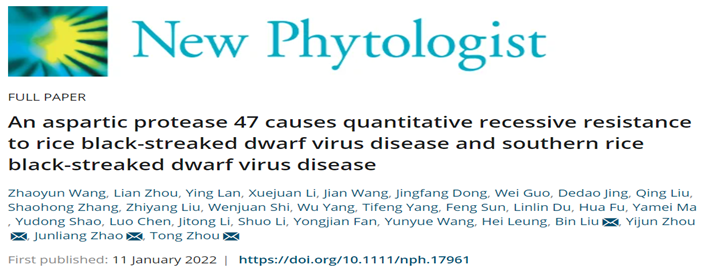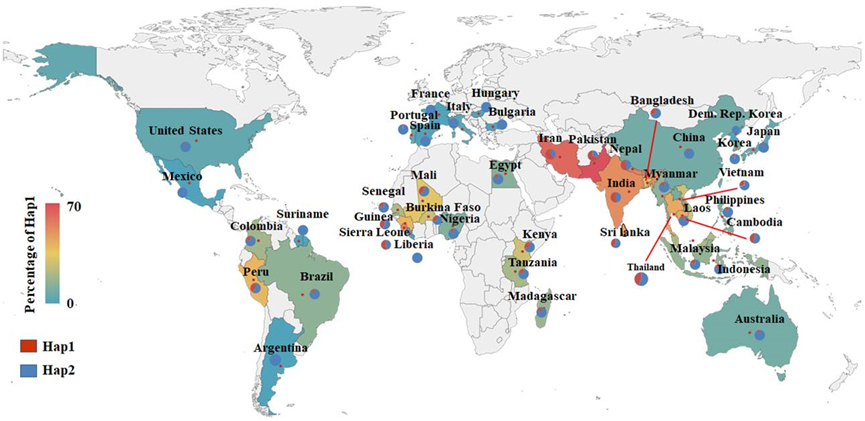
Rice black-streaked dwarf virus (RBSDV) and southern rice black-streaked dwarf virus (SRBSDV) are transmitted by small brown planthoppers (SBPH, Laodelphax striatellus Fallén) and white-backed planthoppers (WBPH, Sogatella furcifera Horváth) respectively. For infected rice, these viruses can cause serious stunted growth, failure in heading, poor seed setting rate, and even seedling death or total loss of grain yield under severe conditions. SRBSDVD and rice blast are the only two rice diseases that are listed in Category A of Crop Diseases and Insect Pests by the Ministry of Agriculture and Rural Affairs of China (http://www.gov.cn/zhengce/zhengceku/ 2020-09/17/content_5544165.htm), and SRBSDVD is also the only virus disease. However, due to the lack of high resistance and stable resources, resistant rice breeding has not made progress. In addition, the resistance genes of these two viral diseases have never been cloned and identified in rice so far, and the molecular mechanism of disease resistance is not clear.
In order to break through the technical bottleneck of the disease-resistant rice breeding and study on the molecular mechanism of disease resistance, the rice viral disease resistance research team of JAAS carried out joint research with Guangdong Academy of Agricultural Sciences and International Rice Research Institute to fully utilize the domestic team in phenotype identification system of rice viral disease, rice genome research on the basis of rice genomic research, and international team’s diverse rice resources. Breakthrough progress has been achieved in anti-resources of screening and disease resistant gene identification.

Figure 1. W44 is a stable resistant accession for RBSDV
In this study, 509 rice core germplasm resources from 59 countries with serious rice black-streaked dwarf virus disease were collected by International Rice Research Institute. Both field trial and artificial inoculation test were conducted to evaluate the RBSDVD resistance. The highly resistant accession was subjected to antibiosis and virus accumulation tests to exclude the insect resistance and preference for plant, and identified the strongest RBSDV resistance variety W44 (Figure 1). Using genome-wide association study (GWAS), linkage disequilibrium (LD) decay analyses, RNA sequencing, sequence alignment analysis and transgenic verification, we confirmed the aspartic protease gene OsAP47 in the main QTL qRBSDV6-1 as the functional gene. This is also the first RBSDV and SRBSDV resistance gene to be cloned and functionally verified in the world (the national invention patent has been applied for). Further analysis of more than 500 germs and 3,000 sequencing rice showed that the resistance haplotype Hap1 of OsAP47 only exists in Indica, and its geographical distribution is mainly in the South Asia and West Africa, which is of great significance to breeding improvement all over the world (Figure 2).

Figure 2. Global geographic distribution of OsAP47 in rice natural populations
Recently, New Phytologist (Impact Factor 10.15, TOP1 of Chinese Academy of Sciences) published the online research paper "An aspartic protease 47 causes quantitative recessive resistance to rice black-streaked dwarf virus disease and southern rice black-streaked dwarf virus disease". The Institute of Plant Protection(JAAS) is the first corresponding organization. Dr. Zhaoyun Wang of JAAS and Dr. Lian Zhou of Guangdong Academy of Agricultural Sciences are the co-first authors. Professor Tong Zhou and Yijun Zhou of JAAS, Professor Bin Liu, and Associate Professor Junliang Zhao of Guangdong Academy of Agricultural Sciences are the co-corresponding authors. Professor Hei Leung of International Rice Research Institute and Professor Yunyue Wang of Yunnan Agricultural University also participated in this research.
The research was supported by the National Natural Science Foundation of China-International (regional) Cooperation (31761143012) and other projects. It is also another important research result since the establishment of JAAS-IRRI Joint Laboratory.
Paper link:https://nph.onlinelibrary.wiley.com/doi/abs/10.1111/nph.17961


